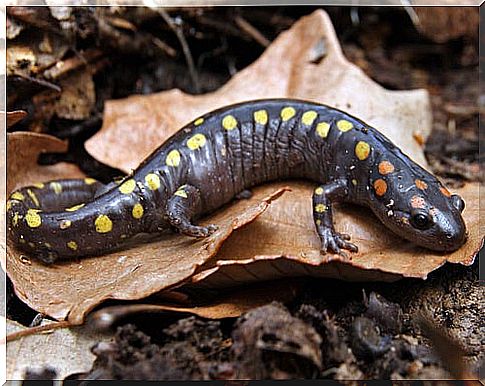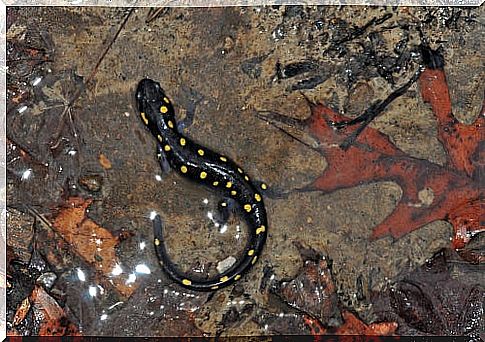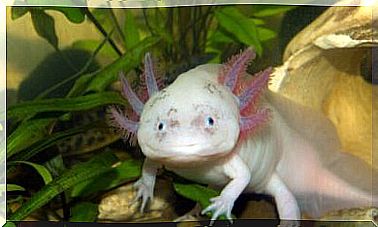Painted Salamander’s Defense Mechanisms

There are many species of salamanders on our planet. Generally, these amphibians usually have one or more defense mechanisms to avoid being captured or eaten. Today, let’s talk about the defense mechanisms of one of them: the painted salamander. Read on to discover more information and to learn more about these elusive animals.
What are the characteristics of the painted salamander?
The painted salamander ( Ambystoma maculatum) is unmistakable. These small amphibians usually measure between 20 and 25 centimeters, including the tail.
We are talking about animals with a robust body as well as short, strong limbs. Your eyes are well developed. Its color pattern is impressive : on its intense black or bluish body two rows of irregular yellow or orange spots appear. We’ll talk about this color pattern in detail later.

Despite its size and coloration, the painted salamander is rarely seen. These are animals that enjoy the hidden underground life. They use other animals’ burrows or hideouts to hide. We can also find them hidden under logs or rocks.
What are the painted salamander’s defense mechanisms?
As we said above, your main defense mechanism is your coloration. The combination of vibrant tones is a warning to predators. This is scientifically known as aposematic coloring and is not unique to the salamander: frogs, wasps and even some plant species also use this strategy.
The next line of defense is also common to most salamanders, and again has to do with their skin. A mucous fluid covers the entire body of the salamander, making it difficult to capture. Sometimes this mucous substance causes an unpleasant taste or odor.

And so we come to his third defensive barrier, the most impressive. When it feels threatened, the painted salamander is able to release a toxin. Through special glands located on the back and tail, they secrete a toxic liquid that can cause uncomfortable irritation, which is another mechanism for warning and punishing predators.
Do salamanders have other defense techniques?
There are cases such as the common salamander ( Salamandra salamandra) . In addition to the defenses mentioned above, these animals can also ‘attack’ with the irritating fluid they secrete. Thanks to a series of conveniently located glands, they are able to spray the predator from a distance.
Among the newts, relatives of salamanders, there is an exceptional case: the protruding ribs salamander ( Pleurodeles waltl) . This species of newt, in addition to releasing a harmful fluid through the skin, also uses the ribs as a defense. She turns her ribs so that they protrude out of her skin, covering them with this same liquid. This makes any attack by a predator ending in punishment. Very interesting, isn’t it?









